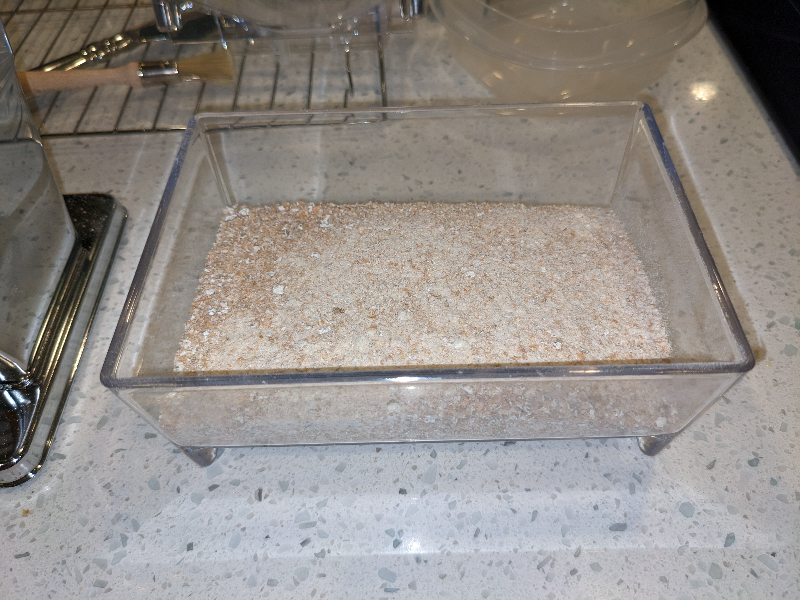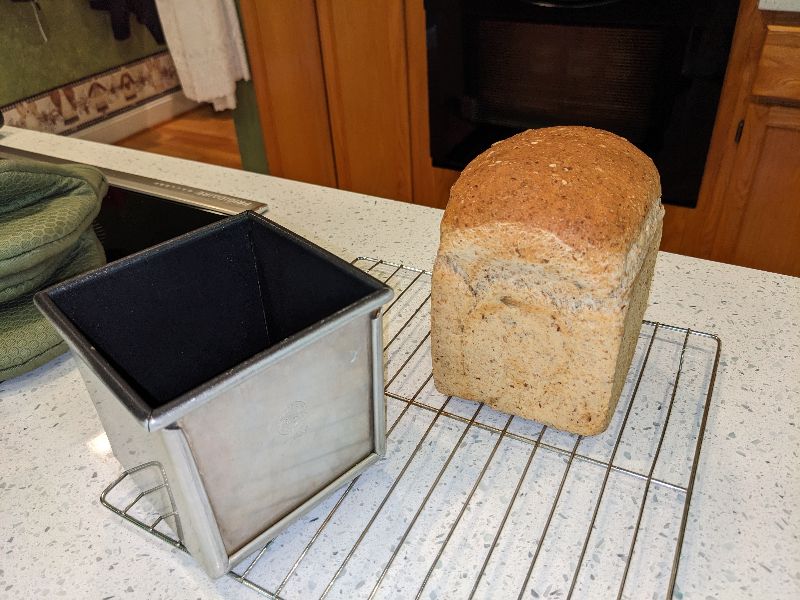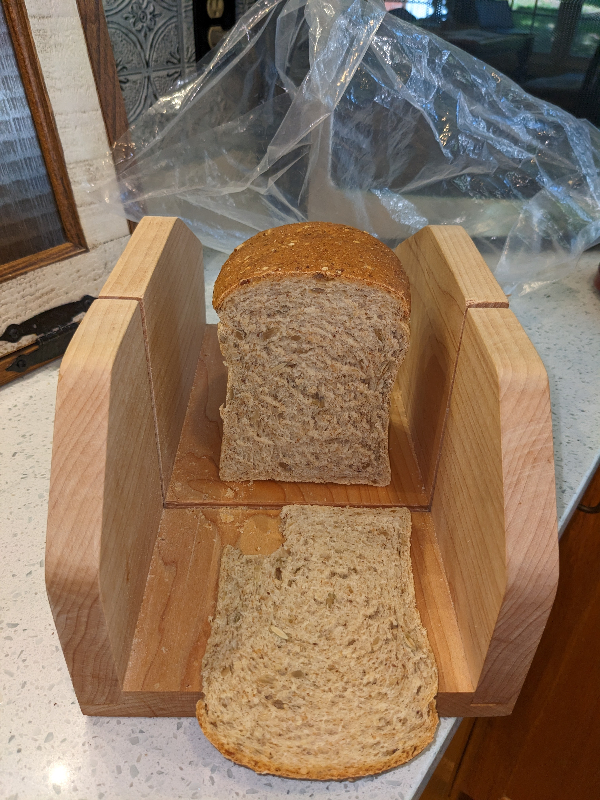
Milling flour with the Marga Mulino Flaker
TLDR: I milled my own flour using the Marcato Marga Mulino and baked a nice soft multigrain loaf.
Pleasant Hill Grains calls it a Flaker and doesn't mention making flour while the Marcato site calls it "the compact mill to grind wheat and grains to make flour, flakes and malt for beer". I think the Marcato characterization is more accurate.
I have successfully made a loaf with 45% milled flour. I milled 15% hard red winter wheat, 15% prairie gold wheat, 10% spelt and 5% rye all together in 6 passes. It took about 5 minutes and low effort to make the 90 grams of flour I needed for my tiny loaf. I wouldn't want to grind a kilogram of flour this way but my large loaves require only 200 grams of whole grain flour.
Of course it makes beautiful flakes as well. Freshly flaked oats and wheat make great tasting and fragrant porridge.
The resulting bread tastes really good and is soft as I make with King Arthur white whole wheat.
Below I include pictures of the flour, loaf and a slice.




Looks like a nice loaf. One thing I noticed the last time I used a coarse grind on wheat berries was that it did not absorb as much water as a finer grind, so the dough was much more sticky during mixing, and I ended up adding more flour after the autolyse and midway through kneading.
I have read that but I did not experience it. The dough behaved just like my usual white whole wheat from King Arthur. All of the whole grain flour in my formula ferments for 3 hours at 86F so maybe it has time to soak up the water?
Hi,
Have you already shared your recipe? What an interesting idea to have coarse grains.
It looks delicious!
I don't know how to measure flour coarseness. Except for the bran it looks and feels like flour to me but what do I know?
Here is a Google Sheet with the recipe. It is the same recipe I've been tweaking for months.
It is delicious and just the right combination of sour, soft and chewy for me.
Gary
I'm up to 100% freshly milled grains now. I milled 50% prairie gold wheat, 30% hard red wheat, 15% spelt and 5% rye berries using my Marga Mulino.
I milled the flour in multiple passes starting at the lowest setting and ending at the highest. I sifted the flour through a strainer that I estimate to be near #20 mesh. I then passed the bran back through the mill. On each repetition of this final step the extraction got higher. I quit at 90% extraction (20g of bran out of 200g of berries).
I used the bran in the 100% hydration preferment. The preferment was 50% of the total flour with 5% of the flour coming from the 100% starter. I let it ferment 3.5 hours at 86F. The pH dropped to 4.8.
Another 10% of the flour went into a yudane at 200% hydration (20g flour and 46g whole milk) heated to 150F. I refrigerated this overnight to see if that makes a difference.
The final dough consists of 40% whole grain flour, 2% King Arthur Whole Grain Bread Improver, 2% salt, 0.4% instant yeast, the preferment, the yudane, 5g water, 10g olive oil and 16g honey.
I mixed the dough with the paddle attachment for 1 minute then let it rest for 30 minutes. I kneaded for 10 minutes at speed 1 with the spiral dough hook adding 15% chopped walnuts for the last 2 minutes. I did a stretch and fold to make it into a ball, let it rest for 20 minutes, did another stretch and fold, then put it in the pan. I let it rise for 1 hour until it reached the top of the pan. Finally, I baked it for 45 minutes at 350F starting from a cold oven.
The resulting loaf looks just like any other from my 4x4x4 inch pan so I won't bother uploading a picture.
It is remarkably soft; I don't think anyone would guess that it is made from coarsely milled flour.
The pH of the baked bread is 4.5.
I am super pleased with the result.
I am very pleased with the performance of the Marcato Marga Mulino mill. It is small, quiet, doesn't heat the grain, inexpensive and plenty fast for my needs.
I have an early version of the Marga Mulino but I imagine it makes the same type of product. I have three choices: coarse flour, coarse flakes or fine flakes. I wanted rye schrot for making pumpernickel and that type of coarse grain is not easy to find, so I ground rye berries on the number "1" coarse flour setting and got very decent results. All I used for the pumpernickel was the rye schrot from the Marga, water, salt, and my rye sourdough starter. After a 24 hour bake, the bread becomes sweet and almost black from the Maillard reaction. i had a few failures because I was not patient enough to wait 24 hours and I used regular rye flour instead of Marga schrot. So, the Marga and precise instructions from the Rus Brot video made my homemade pumpernickel possible.
I've had a couple of failures with pumpernickel. Can I get a link to the instructions?
They were in Russian. That happens to be my field. There is a blog by "Brotgost" and a matching set of YouTube videos by the same person, called Rus Brot on YouTube.
I just checked his blog and you can choose a translation into English or dozens of other languages in the upper right corner. The URL is: https://brotgost.blogspot.com/2018/01/pumpernickel.html
I made a very decent pumpernickel but there was a fatal error: I used a plastic bag and the surface developed mold after a few days. Later I learned that moist bread should never be kept in plastic at room temperature. It invites mold, as happened to me. If I try again I'll wrap it in cloth, use a paper bag, or heat it to make sure the exterior is not so moist.